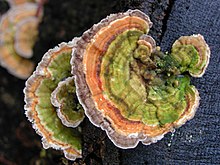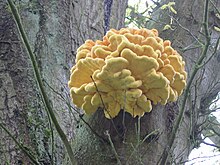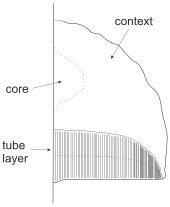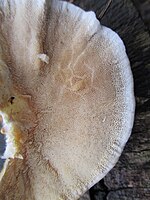Polypore
This article needs additional citations for verification. (November 2009) |

Polypores are a group of
Most polypores inhabit tree trunks or branches consuming the wood, but some soil-inhabiting species form mycorrhiza with trees. Polypores and the related corticioid fungi are the most important agents of wood decay, playing a very significant role in nutrient cycling and aiding carbon dioxide absorption by forest ecosystems.[2]
Over one thousand polypore species have been described to science,[3] but a large part of the diversity is still unknown even in relatively well-studied temperate areas. Polypores are much more diverse in old natural forests with abundant dead wood than in younger managed forests or plantations. Consequently, a number of species have declined drastically and are under threat of extinction due to logging and deforestation.
Polypores are used in traditional medicine, and they are actively studied for their medicinal value and various industrial applications. Several polypore species are serious pathogens of plantation trees and are major causes of timber spoilage.



Conks, the fruiting bodies of polypores, lie in a close planar grouping of separate or interconnected horizontal rows. Brackets can range from only a single row of a few caps, to dozens of rows of caps that can weigh several hundred pounds. They are mainly found on trees (living and dead) and coarse woody debris, and may resemble mushrooms. Some form annual fruiting bodies while others are perennial and grow larger year after year. Bracket fungi are typically tough and sturdy and produce their spores, called basidiospores, within the pores that typically make up the undersurface.
Classification
Because bracket fungi are defined by their growth form rather than
The group includes many different shapes and forms that are common in the tropical forests, including the hard 'cup fungi' and the 'shell', 'plate' and 'bracket' fungus commonly found growing off logs and still standing dead trees.
Description

The fungal individual that develops the fruit bodies that are identified as polypores resides in soil or wood as
Forms of polypore fruit bodies range from mushroom-shaped to thin effused patches (crusts) that develop on dead wood. Perennial fruit bodies of some species growing on living trees can grow over 80 years old (e.g. Phellinus igniarius).[6] Most species of polypores develop new, short-lived fruit bodies annually or several times every year. Abundant fruit takes place during the autumn or rainy season.
Structure of the fruit bodies is simple. Effused or resupinate fruit bodies typically consist of two layers - a tube layer of vertically arranged tubes that open downwards, and supporting layer called subiculum that supports and attached the tubes to substrate. In fruit bodies with a cap (pileate fruit bodies) the tissue between upper surface and the pore layer is called context. A few polypores (e.g. Fomes fomentarius and Inocutis rhaedes) also have a core between context and substrate. A minority of polypores also have a stalk (stipe) that attach to the cap either laterally or centrally depending on the species.
Polypore tubes are a honeycomb-like structure, where the individual tubes have fused together. Their sides are covered with a spore-forming surface, the
-
Polyporus sp. fruit bodies with stalk (Indonesia)
-
Perennial conk of Fomitopsis pinicola on spruce
-
Effused fruit bodies of Meruliopsis taxicola on a pine log
-
bottom side polypore with pores/tubes clearly visible
Ecology
Bracket fungi often grow in semi-circular shapes, looking like trees or wood. They can be
Only basidiomycetes are known to initiate lignin degradation (i.e. cause white rot). A 2012 study linked the end of formation of large-scale coal deposits in the end of the Carboniferous period 300 million years ago to the evolution of lignin-degrading basidiomycetes.[9] More efficient degradation of wood by fungi meant less plant material (and hence less coal) accumulating in the soil.
On the other hand, most brown-rot fungi are polypores. These species have lost their lignin degradation ability but are very efficient in degrading cellulose. Brown-rot fungi are prevalent on conifer hosts and open, sun-exposed habitats. The fungal community in any single trunk may include both white-rot and brown-rot species, complementing each other's wood degradation strategies.
Polypores and other decomposer fungi are the first step in food chains that feed on decomposed plant material. A rich fauna of insects, mites and other invertebrates feed on polypore mycelium and fruiting bodies, further providing food for birds and other larger animals. Woodpeckers and other hole nesting birds typically carve their nests in softer wood decomposed by polypores.[10]
Threats
Almost all polypores are dependent on trees for their survival. Deforestation and intensive forest management cause declines in polypore abundance and diversity. For many species the changes can be too much, and they start a slow slide towards extinction. Since most polypore species are relatively widespread, this process is typically slow. Regional extinctions can happen relatively quickly and have been documented (for instance Antrodia crassa in North Europe[11]).
Polypores can decline for many reasons. They can be dependent on a single host or a very special habitat. For instance
In addition to the host tree individual, the characteristics of the surrounding habitat also matter. Some species prefer closed-canopy forest with a moist, even microclimate that could be disturbed for instance by logging (e.g.
For most declining species the main problem is lack of dead wood in the forest. When suitable tree trunks are too sparse in the landscape, not all species are able to spread to new trunks after old ones have been consumed, causing the population to decline and eventually vanish. Thus, species that are abundant in
Climate change may cause a problem for polypores that are already dependent on a few fragments of old-growth forests and may be unable to migrate with changing vegetation.
Indicator value
Polypores have been used as indicator species of healthy natural forests or
The first indicator list of polypores widely used in forest inventories and conservation work was developed in northern Sweden in 1992 ("Steget före" method).[17][18] "Steget före" list included six polypores in three value classes. In Finland, a list of 30 species for spruce-dominated forests was published in 1993 and widely adopted.[19] Later a similar list for pine-dominated forests was published. Longer lists of indicator species have since been published in Sweden.[20][21]
Many indicator species are
Classification
For most of 20th century polypores were treated as a family, the Polyporaceae. Reconstructions of family trees of fungi show that the
The Polyporales in the modern sense are not only polypores but also other fruiting body types such as crust fungi, hydnoid fungi and agaricoid mushrooms. The term polypore describing a morphological group should not be confused with the taxonomic groups Polyporales or Polyporaceae of the modern literature.
Currently polypores are divided into about 170 genera.[26][27] That number is bound to rise significantly through better understanding of evolutionary relationships between species and through mapping of uncovered diversity in the tropics. All in all classification of polypores is in flux.[28]
Delimitation (morphology)
Most polypores have a poroid hymenium, but not all species. A few, for instance Elmerina holophaea and
Bolete mushrooms are a separate morphological group not included in polypores even though they have tubes. Fleshy fruiting bodies with a stalk and microscopic characters separate boletes from polypores.
-
Irpex lacteus with irregular pores
-
Elmerina holophaea, a polypore with gills
Uses
Some species of bracket fungi are edible, such as
The tinder fungus (Fomes fomentarius) has been used as tinder since at least the time of Ötzi the Iceman. It has also been used to make a material similar to leather.
Ganoderma applanatum, the artist's conk, is used as a substrate for drawings. Fresh specimens develop dark brown lines when drawn upon with a stylus. The lines become permanent when the specimen is dried.[30]
Medicinal uses
Most polypores are edible or at least non-toxic, however one genus of polypores has members that are
Several species have been studied for their ability to produce compounds with anti-pathogenic activity.[35][36]
See also
- Amadou, a flammable substance prepared from bracket fungi
- Pleurotoid fungi have a similar form, but are gilled
- Wood-decay fungus
- List of world's largest mushrooms and conks
References
- ISBN 978-1-4773-2272-7.
- ^ Averill, Colin; Bhatnagar, Jennifer (15 August 2018). "Four Things to Know about Fungi "Climate Warriors" BU researchers explain how fungi fight climate change". The Brink - Research from Boston University. Boston University. Retrieved 1 November 2022.
- ^ Kirk PM et al. (2008) Ainsworth and Bisby's dictionary of the fungi. 10th edition. CABI Europe.
- ^ ISBN 0-330-44237-6. P. 314.
- ISBN 978-0-06-040839-8.
- ^ Gäumann, Ernst Albert (1928). Comparative Morphology of the Fungi. New York: McGraw-Hill. p. 447.
- ^ Gilbertson RL, Ryvarden L (1986) North American polypores 1, Abortiporus to Lindtneria. Oslo, Fungiflora.
- S2CID 20812924.
- S2CID 37121590.
- ISBN 978-952-5980-07-3.
- ^ Junninen K (2009) Conservation of Antrodia crassa. Metsähallituksen luonnonsuojelujulkaisuja, sarja A 182: 1–51.
- ^ Gilbertson RL, Ryvarden L (1986) North American polypores 1, Abortiporus to Lindtneria. Oslo, Fungiflora.
- ^ "査定の前にすべきこと – 鉄道模型の買取でBトレインショーティーの買取".
- ^ Ledo, D. (2007). Species Fact Sheet: Bridgeoporus nobilissimus (Report). Portland, Oregon: Interagency Special Status/Sensitive Species Program. USDA Forest Service and USDI Bureau of Land Management.
- .
- ISBN 978-0521048187.
- ^ Karström M (1992) Steget före – en presentation. Svensk Botanisk Tidskrift 86: 103-114.
- ^ "Steget Före-metoden". Archived from the original on 2010-08-11. Retrieved 2013-04-13.
- ^ Kotiranta H, Niemelä T (1996) Uhanalaiset käävät Suomessa. 2nd ed. Suomen ympäristökeskus, Helsinki.
- ^ Nitare J (2000) Signalarter. Indikatorer på skyddsvärd skog. Flora över kryptogamer. Skogsstyrelsen förlag, Jönköping.
- ^ "Signalarter - Skogsstyrelsen". Archived from the original on 2014-10-06. Retrieved 2014-10-05.
- S2CID 4686378.
- S2CID 23931256.
- ^ Ryvarden L, de Meijer AAR (2002) Studies in neotropical polypores 14. New species from the state of Paraná, Brazil. Synopsis Fungorum 15: 34–69.
- S2CID 30033595.
- ^ Ryvarden L (1990) Genera of polypores. Fungiflora, Oslo.
- ^ MycoBank (http://www.mycobank.org)
- PMID 28800851.
- ISBN 978-0-472-03126-9.
- ISBN 978-0-226-72117-0.
- S2CID 24320633.
- PMID 24786572.
- PMID 25794896.
- PMID 14987072.
- PMID 26756184.
External links
 Media related to Bracket fungi at Wikimedia Commons
Media related to Bracket fungi at Wikimedia Commons- Chisholm, Hugh, ed. (1911). . Encyclopædia Britannica (11th ed.). Cambridge University Press.






